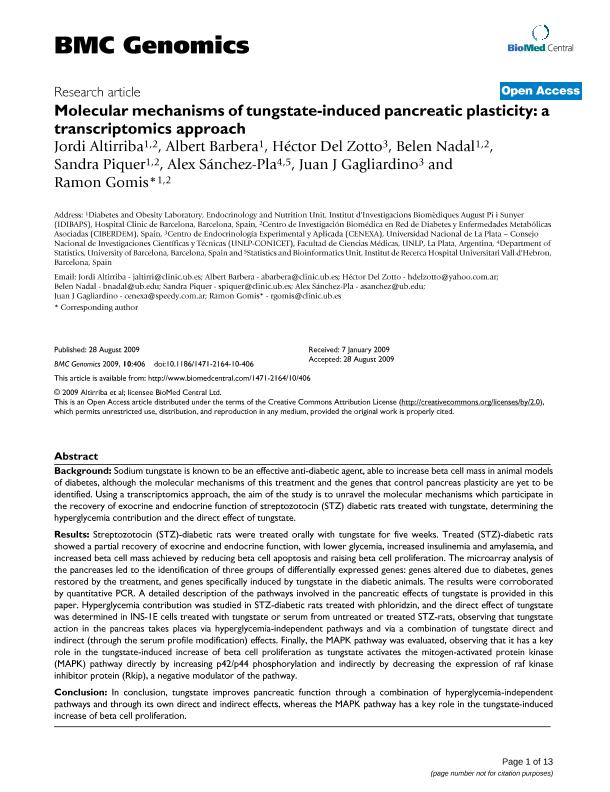Mostrar el registro sencillo del ítem
dc.contributor.author
Altirriba, Jordi
dc.contributor.author
Barbera, Albert
dc.contributor.author
del Zotto, Hector Herminio

dc.contributor.author
Nadal, Belen
dc.contributor.author
Piquer, Sandra
dc.contributor.author
Sánchez Pla, Alex
dc.contributor.author
Gagliardino, Juan Jose

dc.contributor.author
Gomis, Ramon
dc.date.available
2020-02-03T19:53:46Z
dc.date.issued
2009-08
dc.identifier.citation
Altirriba, Jordi; Barbera, Albert; del Zotto, Hector Herminio; Nadal, Belen; Piquer, Sandra; et al.; Molecular mechanisms of tungstate-induced pancreatic plasticity: A transcriptomics approach; BioMed Central; BMC Genomics; 10; 1; 8-2009; 1-13
dc.identifier.issn
1471-2164
dc.identifier.uri
http://hdl.handle.net/11336/96573
dc.description.abstract
Background: Sodium tungstate is known to be an effective anti-diabetic agent, able to increase beta cell mass in animal models of diabetes, although the molecular mechanisms of this treatment and the genes that control pancreas plasticity are yet to be identified. Using a transcriptomics approach, the aim of the study is to unravel the molecular mechanisms which participate in the recovery of exocrine and endocrine function of streptozotocin (STZ) diabetic rats treated with tungstate, determining the hyperglycemia contribution and the direct effect of tungstate. Results: Streptozotocin (STZ)-diabetic rats were treated orally with tungstate for five weeks. Treated (STZ)-diabetic rats showed a partial recovery of exocrine and endocrine function, with lower glycemia, increased insulinemia and amylasemia, and increased beta cell mass achieved by reducing beta cell apoptosis and raising beta cell proliferation. The microarray analysis of the pancreases led to the identification of three groups of differentially expressed genes: genes altered due to diabetes, genes restored by the treatment, and genes specifically induced by tungstate in the diabetic animals. The results were corroborated by quantitative PCR. A detailed description of the pathways involved in the pancreatic effects of tungstate is provided in this paper. Hyperglycemia contribution was studied in STZ-diabetic rats treated with phloridzin, and the direct effect of tungstate was determined in INS-1E cells treated with tungstate or serum from untreated or treated STZ-rats, observing that tungstate action in the pancreas takes places via hyperglycemia-independent pathways and via a combination of tungstate direct and indirect (through the serum profile modification) effects. Finally, the MAPK pathway was evaluated, observing that it has a key role in the tungstate-induced increase of beta cell proliferation as tungstate activates the mitogen-activated protein kinase (MAPK) pathway directly by increasing p42/p44 phosphorylation and indirectly by decreasing the expression of raf kinase inhibitor protein (Rkip), a negative modulator of the pathway. Conclusion: In conclusion, tungstate improves pancreatic function through a combination of hyperglycemia-independent pathways and through its own direct and indirect effects, whereas the MAPK pathway has a key role in the tungstate-induced increase of beta cell proliferation.
dc.format
application/pdf
dc.language.iso
eng
dc.publisher
BioMed Central

dc.rights
info:eu-repo/semantics/openAccess
dc.rights.uri
https://creativecommons.org/licenses/by/2.5/ar/
dc.subject
TUNGSTATO
dc.subject
CELULAS B
dc.subject
DIABETES
dc.subject
MASA DE CELULS B
dc.subject.classification
Farmacología y Farmacia

dc.subject.classification
Medicina Básica

dc.subject.classification
CIENCIAS MÉDICAS Y DE LA SALUD

dc.title
Molecular mechanisms of tungstate-induced pancreatic plasticity: A transcriptomics approach
dc.type
info:eu-repo/semantics/article
dc.type
info:ar-repo/semantics/artículo
dc.type
info:eu-repo/semantics/publishedVersion
dc.date.updated
2019-11-25T18:41:09Z
dc.journal.volume
10
dc.journal.number
1
dc.journal.pagination
1-13
dc.journal.pais
Reino Unido

dc.journal.ciudad
Londres
dc.description.fil
Fil: Altirriba, Jordi. Hospital Clinic de Barcelona; España. Centro de Investigación Biomédica en Red de Diabetes y Enfermedades Metabólicas Asociadas; España
dc.description.fil
Fil: Barbera, Albert. Hospital Clinic de Barcelona; España
dc.description.fil
Fil: del Zotto, Hector Herminio. Consejo Nacional de Investigaciones Científicas y Técnicas. Centro Científico Tecnológico La Plata. Centro de Endocrinología Experimental y Aplicada (i); Argentina. Universidad Nacional de La Plata. Facultad de Ciencias Médicas; Argentina
dc.description.fil
Fil: Nadal, Belen. Hospital Clinic de Barcelona; España. Centro de Investigación Biomédica en Red de Diabetes y Enfermedades Metabólicas Asociadas; España
dc.description.fil
Fil: Piquer, Sandra. Centro de Investigación Biomédica en Red de Diabetes y Enfermedades Metabólicas Asociadas; España. Hospital Clinic de Barcelona; España
dc.description.fil
Fil: Sánchez Pla, Alex. Universidad Autónoma de Barcelona. Hospital Vall D' Hebron; España. Universidad de Barcelona; España
dc.description.fil
Fil: Gagliardino, Juan Jose. Universidad Nacional de La Plata. Facultad de Ciencias Médicas; Argentina. Consejo Nacional de Investigaciones Científicas y Técnicas. Centro Científico Tecnológico La Plata. Centro de Endocrinología Experimental y Aplicada (i); Argentina
dc.description.fil
Fil: Gomis, Ramon. Centro de Investigación Biomédica en Red de Diabetes y Enfermedades Metabólicas Asociadas; España. Hospital Clinic de Barcelona; España
dc.journal.title
BMC Genomics

dc.relation.alternativeid
info:eu-repo/semantics/altIdentifier/url/https://bmcgenomics.biomedcentral.com/articles/10.1186/1471-2164-10-406
dc.relation.alternativeid
info:eu-repo/semantics/altIdentifier/doi/https://doi.org/10.1186/1471-2164-10-406
Archivos asociados
